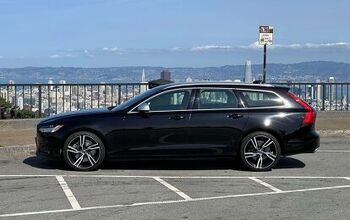2012 Volvo XC60 T6 R-Design
With Saab’s death dragging on month after month, fans of Sweden’s plucky little auto industry haven’t had much to celebrate recently. Volvo launched the most powerful car in its history, the 325-horspower Volvo S60 T6 R-Design, and hardly anyone bothered to notice. When one of the buff books got around to testing the compact all-wheel-drive sport sedan, they compared it to a four-pot front-wheel-drive Buick, and concluded that the Buick is better. Against the Audi S4 I found the S60 a clear second. Those seeking a segment-leading Swede need not despair, though. Just do what I did right after driving the S60 in Charleston, WV, and check out a different, less mature segment: compact premium SUVs. The XC60 T6 R-Design, with a couple of power bumps since it was introduced two years ago, might just be the best of the bunch.
Though no one will mistake it for a Honda, the XC60’s exterior has never worked for me in gray-cladded, small-wheeled base trim. The R-Design treatment addresses my reservations, and then some. Paint the cladding body color and fit 20-inch five-spoke wheels, and suddenly the overhangs don’t appear oddly stretched. Most likely this is the look the designers had in mind when they were carving the clay.
Scandinavian furniture has been popular among a certain social stratum for decades for a reason: northern Europeans are masters of tastefully stylish modern design. The same aesthetic has been applied inside the latest Volvos, including this one. Nothing remotely over the top, but even in the tested dark gray with cream accents much warmer than a German auto interior. Materials are more-or-less in line with the price.
This being a Volvo, the seats are among the most comfortable you’ll find. Much cushier than those in German competitors, yet also properly supportive fore-aft and laterally. But the S60 sedan has similar, perhaps identical seats, and they haven’t been enough to win comparison tests. So what’s the XC60 got that the related sedan doesn’t? Answer: a higher, much more open driving position. You can more easily see over the dash and between the more upright pillars of the crossover. The XC60 might not be ye olde 240, but it’s more of a spiritual successor than the new S60. This enhances both perceived agility and actual safety. The driver rightfully feels more confident behind the wheel.
The XC60 is also a much happier place for rear seat passengers. The crossover’s back seat is much roomier and mounted comfortably high off the floor. And cargo space? A sedan with a smallish trunk can’t begin to compete with a crossover. The front passenger seat folds to extend the cargo area in both, a rarity in premium cars, but this feature is even more useful with a rear hatch. The V60 wagon variant, currently not offered in North America, would put up more of a fight.
For 2012, the XC60 T6 R-Design has the same powertrain as the S60 T6 R-design, a transversely-mounted 325-horsepower, 354 pound-feet turbocharged 3.0-liter inline six connecting to all four wheels via a manually-shiftable six-speed automatic and Haldex-based all-wheel-drive system:
Sorry, couldn’t resist sneaking in this photo. The dealership’s owner parks his personal collection in the service area, and it includes a “continuation” Cobra. The service writer who popped the hood for me reported that this beautiful multi-throttled V8 was a $30,000 option. The Volvo’s engine:
The Polestar tune adds 25 horsepower and 29 pound-feet to the engine that powered last year’s R-Design and that continues to power the regular T6. The engine in the 2010 R-Design was good for “only” 281 horsepower. You can get more than 325 horsepower in a compact sedan. But in the compact SUV segment this is the most potent powerplant available. (At least on paper; BMW might understate the output of the X3 xDrive35i’s 300-horsepower engine.) The XC60 crossover weighs significantly more than the S60 sedan, 4,236 to 3,877 pounds. But from the driver’s seat the XC60 feels at least as quick, perhaps even a little quicker. Credit the more commanding driving position, from which you can better view the outside world as the Volvo passes rapidly through it. The Haldex system does have the same limitations here. It doesn’t instantaneously shunt power to the rear wheels, so with a hard launch there’s a split second of wheel spin and torque steer.
By any objective measure, the S60 outhandles the XC60. There’s no defeating the laws of physics as they apply to extra pounds and a center of gravity farther from the ground. But expectations are also lower for a crossover, and direct competitors are less talented. Audi offers no S variant of its Q5. And the BMW X3 xDrive35i, while certainly an outstanding performer, has vague steering and a cold personality. The XC60 does not have the S60’s selectable-assist steering. The system it does have is similar to the sedan’s in its “light” setting, but with a less artificial feel. Not sportily hefty, and not as communicative as the system in an Audi Q5, but intuitive and good for perceived agility. The crossover’s suspension tuning isn’t as aggressive as the sedan’s nor is it abetted by brake-based torque vectoring, and partly as a result its handling feels more fluid and natural while its ride feels smoother and steadier. Add in the XC60’s driving position, and I actually found it more fun to drive than the more stiffly suspended S60 or any competing compact crossover. While the BMW would be quicker along a challenging road, I enjoyed the Volvo more. Well, until I had to stop. Even more than in the S60, Charleston’s steep winding roads made it clear that the Volvo’s brakes aren’t as strong as its engine.
Equipped like the related sedan, the XC60 lists for about $2,000 more. The R-Design starts at $44,025. Add a couple packages and the blind-spot warning system to get heated seats, keyless access, nav, and an outstanding audio system, and you’re at $50,175. But, as is often the case with a crossover, the XC60 includes more features than the S60. Things like a power liftgate, two-panel (instead of conventional) sunroof, bi-directional obstacle detection, rear privacy glass, and a slew of cargo-related accessories. Adjust the XC60’s price for this additional content using TrueDelta’s car price comparison tool, and the XC60 emerges the better value by about $900. And a similarly-equipped BMW X3 xDrive35i? It’s $3,750 more before adjusting for feature differences, and about $2,700 more afterwards.
The XC60 T6 R-Design is roomier, more comfortable, more functional, and more fun-to-drive than the S60 sedan. A BMW X3 is a stronger performer and better handler, but the Volvo has more attractive styling, a more natural feel, and those oh-so-comfy seats. On top of this, the XC60 fits Volvo’s heritage. While three generations of R sedans have never quite achieved top shelf status, people have long gone to Volvo for fast, functional wagons. The XC60 is the natural evolution of these wagons, a little taller but casting a smaller shadow. Car buyers seem to agree. It’s easy to find a dealer with plenty of S60s in stock. XC60s are another matter. If I were to buy a premium brand compact crossover or a Volvo, it would be this one.
Vehicle provided by Chris Myers of Smith Company Motor Cars in Charleston, WV. Chris can be reached at 304-746-1792.
Michael Karesh operates TrueDelta.com, an online provider of car reliability and real-world fuel economy information.
Michael Karesh lives in West Bloomfield, Michigan, with his wife and three children. In 2003 he received a Ph.D. from the University of Chicago. While in Chicago he worked at the National Opinion Research Center, a leader in the field of survey research. For his doctoral thesis, he spent a year-and-a-half inside an automaker studying how and how well it understood consumers when developing new products. While pursuing the degree he taught consumer behavior and product development at Oakland University. Since 1999, he has contributed auto reviews to Epinions, where he is currently one of two people in charge of the autos section. Since earning the degree he has continued to care for his children (school, gymnastics, tae-kwan-do...) and write reviews for Epinions and, more recently, The Truth About Cars while developing TrueDelta, a vehicle reliability and price comparison site.
More by Michael Karesh
Latest Car Reviews
Read moreLatest Product Reviews
Read moreRecent Comments
- MaintenanceCosts Poorly packaged, oddly proportioned small CUV with an unrefined hybrid powertrain and a luxury-market price? Who wouldn't want it?
- MaintenanceCosts Who knows whether it rides or handles acceptably or whether it chews up a set of tires in 5000 miles, but we definitely know it has a "mature stance."Sounds like JUST the kind of previous owner you'd want…
- 28-Cars-Later Nissan will be very fortunate to not be in the Japanese equivalent of Chapter 11 reorganization over the next 36 months, "getting rolling" is a luxury (also, I see what you did there).
- MaintenanceCosts RAM! RAM! RAM! ...... the child in the crosswalk that you can't see over the hood of this factory-lifted beast.
- 3-On-The-Tree Yes all the Older Land Cruiser’s and samurai’s have gone up here as well. I’ve taken both vehicle ps on some pretty rough roads exploring old mine shafts etc. I bought mine right before I deployed back in 08 and got it for $4000 and also bought another that is non running for parts, got a complete engine, drive train. The mice love it unfortunately.











































Comments
Join the conversation
As an owner of seven Volvos, beginning in 1970 and ending with the current 2010 T6, I can tell you each successive model we have bought is better assembled (detailing in the interior, tighter tolerances / panel fit inside and out, more refinement). In none of the models from 1995 - 2010 have we had any serious mechanical issues whatever. Several minor DOT recall notices, that is all. Other than about 140 - 150,000 miles on the 1970, which was well past its prime, the next highest number was about 56,000 on the 2004 V70R. I especially appreciate that Volvo eschews aping the mighty fine German brands point by point, which are over the top in complexity and too many gizmos. For too long Volvo was too Amish spartan, but from the days when Ford purchased Volvo, the American ownership introduced needed freedom of expression outside the Swedish envelope. Steve Mattin, the British stylist hired by Volvo, who was responsible for the XC60, did a magnificent, IMO. And if you consider the Safe and Secure warranty / maintenance program (5 yrs., 50,000 mile currently; the 2010 has 5 yrs., 60,000 miles) an incentive from both a customer and manufacturer's point of view, then Volvo clearly bests Audi's plan and in some aspects is better than BMW or Mercedes Benz. One more point: the new IIHS slight offset crash test illustrates Volvo's DNA since its beginning. As much as I admire the Germans, I very much doubt I would ever pick their CUVs over the XC60.
Old thread. We have owned this exact vehicle for 5 years now. Purchased CPO @22k miles for half the sticker. Recently the front wheel came off doing triple digits in the Utah desert. Coasted to a stop, no drama, but the whole corner of the car was ripped-up by the wheel as it left. We considered replacing it and looked around. Decided there is still nothing on the market we would clearly prefer. The SQ5 and the X5 40 are the closest equivalents, list at $60k and are not superior, except fuel mileage. The XC60 is quiet, comfortable, very quick, decent-handling, roomy for 4, built like a tank and has been almost completely trouble-free. The seats are GREAT, as they were in the V70R that preceded it. Audio system is excellent. And when that wheel came off, we were very happy to be in that vehicle. (Tire shop error mounting winters). To top it all off, the XC60 is fairly wicked offroad with the right tires/wheels. The R-design without air suspension loses some ground clearance (otherwise best in class, I believe) but there were some quizzical looks from F150 and Rubicon-Driving hunters when I took her up a remote road here in CO. The design still looks fresh too. Would do it all over again in a blink. The dealership that did the repairs also sells the new Buick wagon. I asked if I should try it out. Service manager: "I don't think you're interested". "How's that?" "I drove your car. Do you know how fast that thing is?" "Yes, I do."